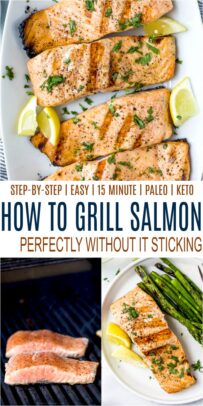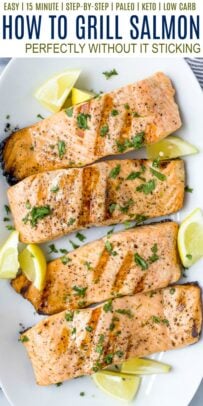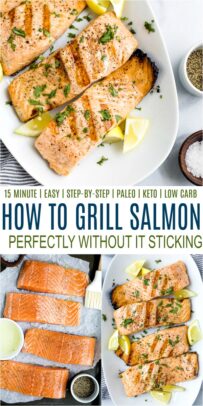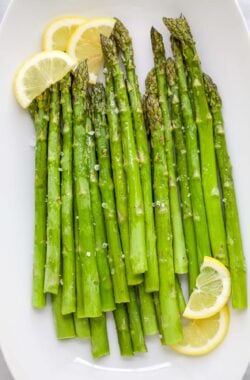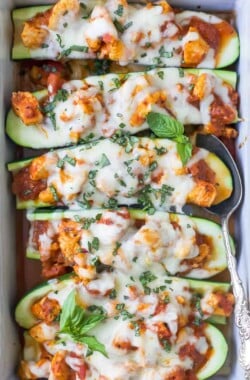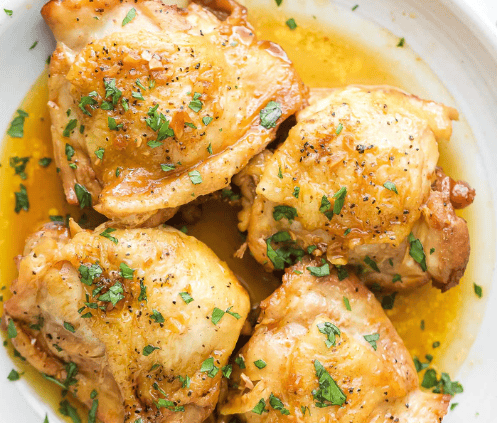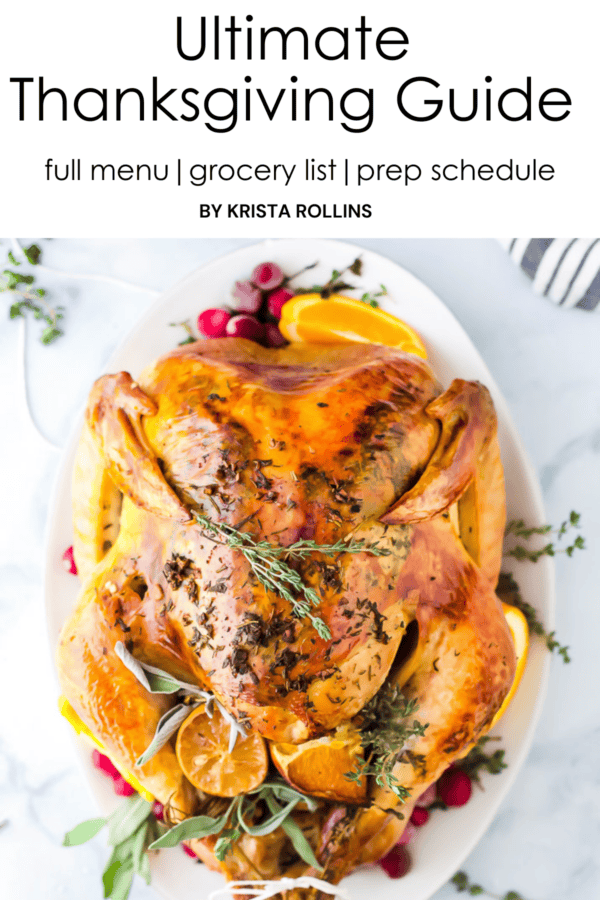Wondering how to grill salmon? This simple step-by-step guide will help you cook it up perfectly, every time. No marinade necessary, and ready in 15 minutes!
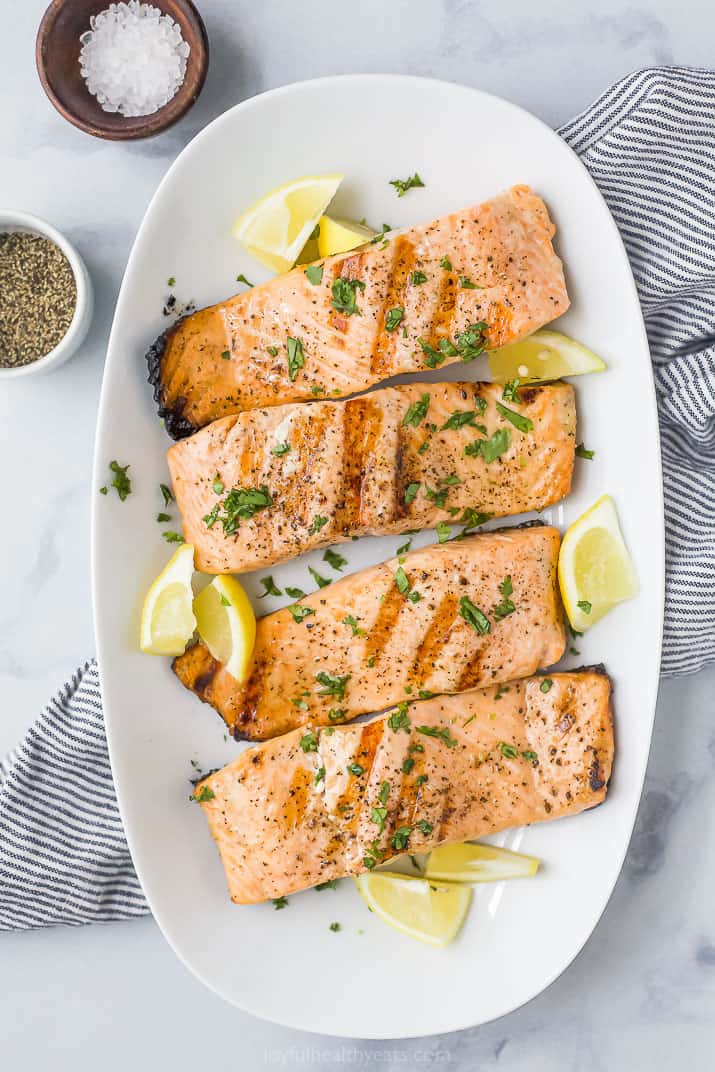
Is your salmon grilling up to par? Not sure? You’ve come to the right place. I know the first couple of times I made it, I was nervous and had so many questions. Should I start skin side up or down? Do I spray the grates or grill on foil? Do I flip it or not?
Whether you’re new to grilling salmon or just looking to polish your skill set, this tutorial will get you where you want to be in no time. I’ll walk you through things to consider when selecting salmon for the grill, actual grilling technique, times, and temperature. Plus we’ll cover some useful tips that are great to have in your back pocket. Ready? I hope so!
What’s The Best Salmon for Grilling?
- What kind of salmon to use: Choose a salmon variety that has relatively firm flesh, as it will hold together on the grill better than more delicate fillets. Sockeye is probably the most common choice but you could also grab Coho, Chinook, or Atlantic salmon.
- Make sure it’s fresh: This is important. Look for salmon that has light to dark pink or even reddish color. No brown allowed. The flesh of the fish should look firm, as opposed to mushy, and it should smell faintly of ocean water. If the salmon smells fishy, walk away.
- What cut? I recommend going for a center-cut fillet and slicing it into 4-6 ounce portions. Center-cut fillets tend to be thicker and more uniform in thickness. They hold up well on the grill and yield an evenly cooked finished product. You could also use salmon steaks if you’d like.
- Leave the skin on: The skin will help hold the flesh of the fish together and keep it from drying out.
- Wild-caught or farm-raised? The choice is yours. Farm-raised salmon will be a bit fattier and more melt-in-your-mouth, while wild-caught will be leaner and more flavorful.
- Can I use frozen salmon? Where possible, go for fresh salmon. It’s just downright better in terms of taste and texture. If it’s not available, however, you can use frozen. Allow it to thaw in the refrigerator before grilling for best results.

What You’ll Need
Here’s a quick look at what you’ll need to make this grilled salmon recipe.
- Salmon Fillet: I like to buy a salmon fillet with skin on and then cut my own portions but to make it easier you can buy them pre-cut. Either way make sure they have skin on.
- Tasteless Oil: Oils that are tasteless and can handle high heat are key. Avocado oil is what I normally use, but peanut oil, grapeseed oil, or vegetable oil would do.
- Salt & Pepper: These are a must for anything you make.
- Grilling Utensils: I love using my fish spatula or tongs to flip, so I don’t break the salmon up when I flip.
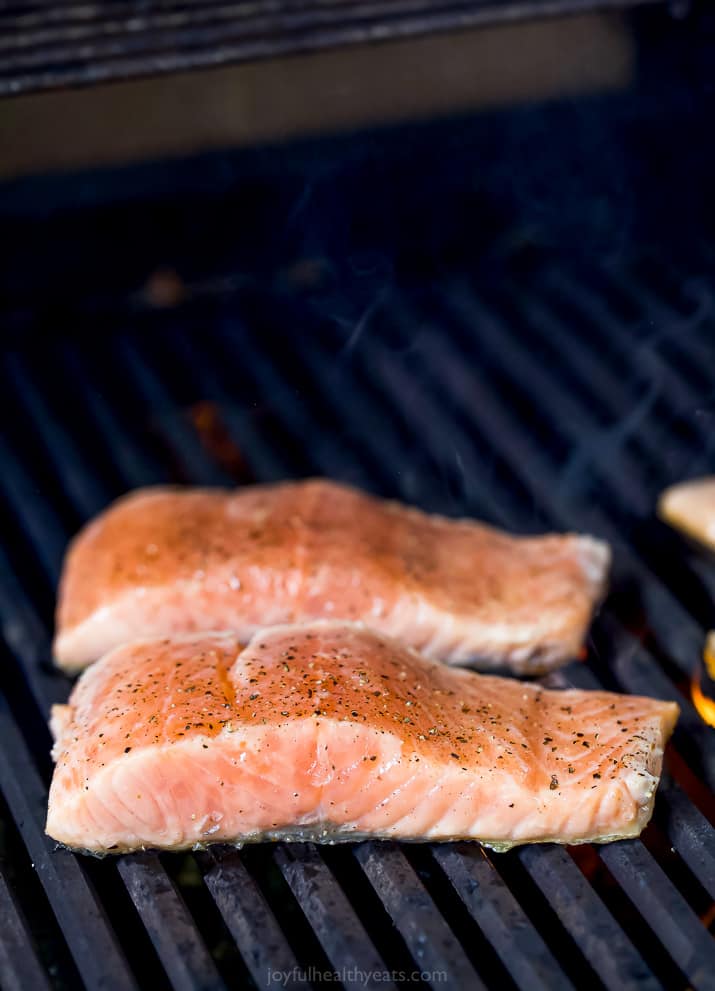
How to Grill Salmon
And now to the good stuff. How to actually grill the BEST salmon. This is just a general overview. For specific recipes with fun seasoning, sauces, etc. have a look at the section below titled “6 Grilled Salmon Recipes to Try
- Preheat the grill. Set your grill to high heat (400-450°F).
- Prepare the salmon. Pat the salmon fillets dry with paper towels and brush them with olive oil or melted butter. Season with salt, pepper, and whatever else you have in store.
- Grill the salmon. Place the salmon directly on the grill* over direct heat, skin side down (if grilling fillets, you won’t have to worry about this with steaks). Grill for 6-8 minutes. If you are using a sauce, brush the salmon with the sauce once or twice as it cooks.
- Flip and finish cooking. Use a spatula to carefully flip the salmon and continue grilling for another 1-2 minutes, or until the salmon reaches your desired level of doneness. The internal temperature should reach 130 degrees F.
- Rest. Remove the salmon from the grill and let it rest for 5 or so minutes before serving.
Don’t want to cook directly on the grill? Place the salmon on a grilling plank or a cast iron instead. Just be sure to preheat the cast iron first. How? Just place it in the grill as it heats up. By the time your grill is preheated, the pan should be too.
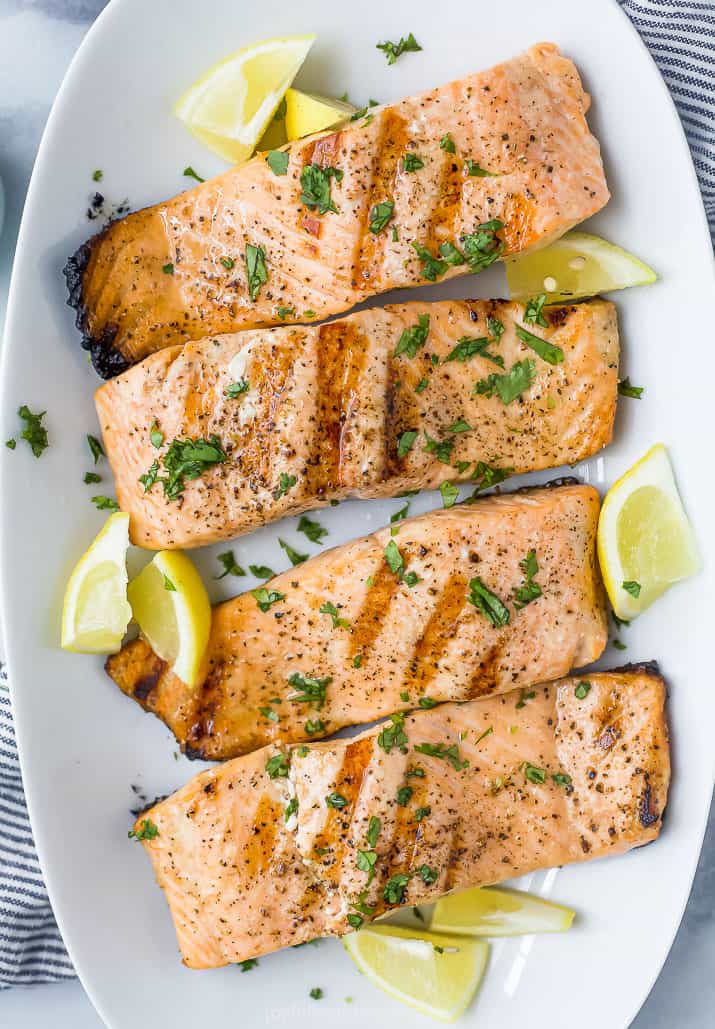
Frequently Asked Questions
I like grilling salmon at around 400-450 degrees F. This is the perfect temperature to ensure that the salmon cooks evenly and achieves a nice char on the outside.
No. You don’t have to. But if you want the grill marks on the salmon and a crust, you’ll want to. I recommend starting grilling skin side down first because the skin can handle the majority of the high heat without burning the salmon. It will release from the grill without sticking, so you can flip and grill flesh side down for 1-2 minutes to get those nice char marks and seared crust! YUM
This is one of the things that people struggle with most when cooking salmon. The most commonplace way to check if your salmon is done is to insert a fork into the thickest part of the fillet. If the fish flakes easily and has a nice opaqueness to it, you’re good to go. Still not sure? Insert a meat thermometer into the thickest part of the salmon. It should read 130°F. Keep in mind that the salmon will continue to cook for a few minutes after you remove it from the grill, reaching a safe internal temperature of around 145 degrees F.
It depends! Cooking directly on the grate allows the fish to get a lovely char on it and really contributes to the flavor, in my opinion. If you are working with thinner, more delicate fillets, however, it is best to grill them in foil as this will help keep them from falling apart.
How Do I Prevent the Salmon From Sticking to the Grill?
- HOT Grill: A searing hot grill is key. You want to grill your salmon HOT and fast. As soon as one side is done cooking, it will release from the grill so you can flip and grill the other side.
- Keep the Skin: The skin-on method will give your salmon a protective barrier from the high heat. It also helps hold the fish together and prevents it from sticking to the grill or falling apart when you do flip.
- Oil the Fish, Not the Grates: Brushing the fish with oil instead of the grates ensures that the oil is on the protein when it hits the high heat and will help it not stick to the grill.
- Use a Grilling Plank: This Honey Garlic Cedar Plank Salmon Recipe is seriously bomb, I highly recommend it.
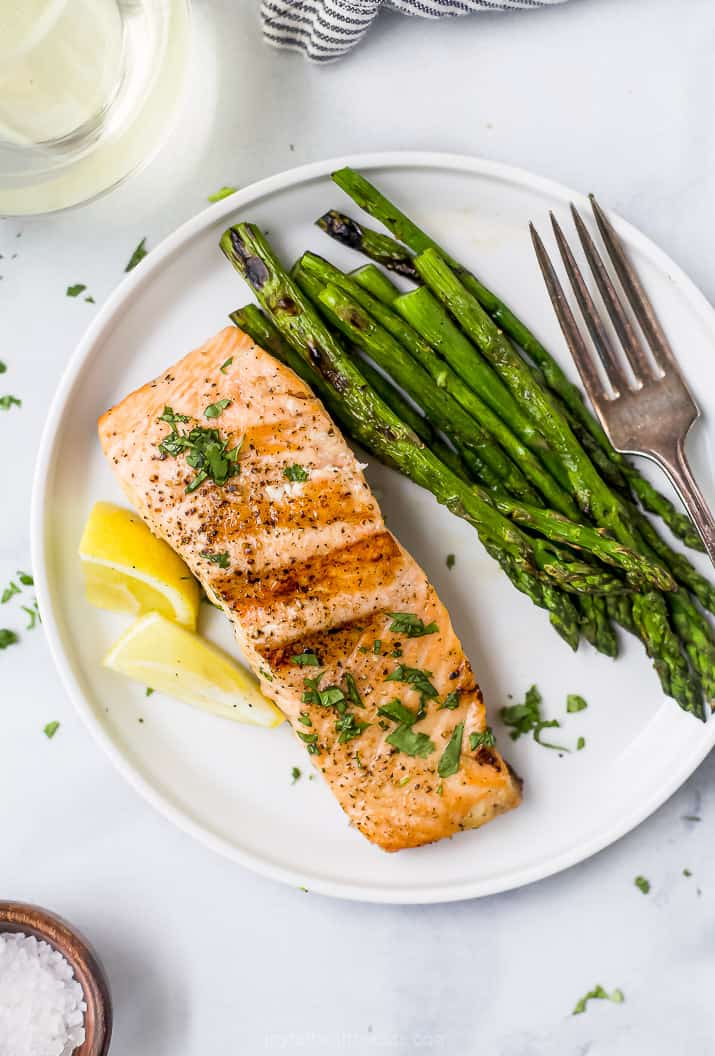
Toppings
So now that you have perfectly grilled, flaky salmon, what are you going to do with it? Here are some simple toppings you can serve your salmon with:
- Avocado Salsa
- Mango Avocado Salsa
- Creamy Dijon Sauce
- Strawberry Salsa
- Fresh Lemon Slices
- Lemon Garlic Butter Sauce
- Fresh Herbs – like rosemary, thyme or dill
Side Dish Ideas
So now that you have perfectly grilled, flaky salmon, what are you going to do with it? Here are some ideas to get you inspired.
- Cooked veggies. I love serving grilled salmon with simple cooked veggies. Try Air Fryer Asian Brussel Sprouts or these Perfectly Crispy Air Fryer Green Beans. Better yet, double up on grilling with my Ultimate Guide for the Best Grilled Vegetables.
- Salad. Grilled salmon and a light salad is the ideal summer lunch, in my opinion. Try my Green Goddess Salad, Fattoush Salad.
- Grain salad. Add a flaky piece of grilled salmon to the top of this Thai Quinoa Salad or Farro Salad with Maple Dijon Dressing.
- Potatoes. Get a little potato and a little salmon on your fork and you are in for the perfect bite. Try these Air Fryer Roasted Potatoes, my Crispy Garlic Herb Roasted Potatoes, or these Creamy Mashed Potatoes.
Wine Pairings
Want to serve your grilled salmon with a glass of wine? Here are my favorite clean brands that pair perfectly with fish:
- Adelante Sauvignon Blanc
- Fieldhouse White Blend
- Che Fico Pinot Grigio
- Fiddleneck Muscat Blanc
- Dove Hunt Dog Rosé
- Middle Jane Pinot Noir
- Gallivant Chardonnay
Proper Storage
- Refrigerator. Allow the salmon to cool completely. Place it in an airtight container or wrap it tightly in plastic wrap and store it in the fridge for up to 3 days.
- Freezer. Once the salmon has cooled to room temperature, seal it in a freezer-safe, airtight container. Alternatively, you can wrap the individual fillets tightly in plastic wrap followed by aluminum foil (this will help protect it from freezer burn). Store in the freezer for up to 3 months. Allow the salmon to thaw in the refrigerator before reheating.
- To reheat. Arrange the salmon in a single layer in a baking dish and cover with aluminum foil. Bake in the oven at 275 degrees F for 10-15 minutes or until heated through.
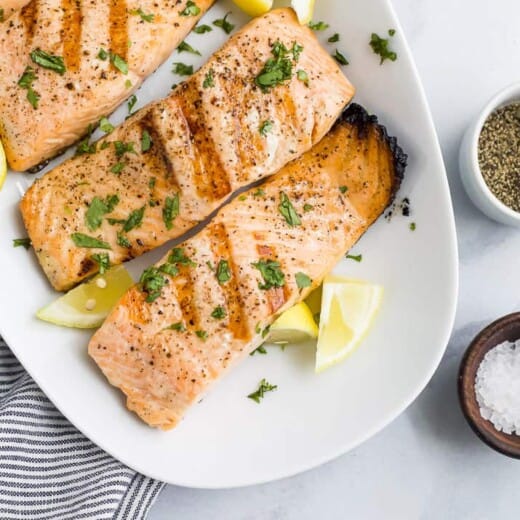
How to Grill Salmon
- Prep Time: 5 minutes
- Cook Time: 10 minutes
- Total Time: 15 minutes
- Yield: 4 1x
- Category: Fish
- Method: Grill
- Cuisine: American
- Diet: Gluten Free
Description
How to Grill Salmon perfectly every time without it sticking to the grill! An easy step-by-step guide to grilling salmon, no marinade necessary. Get a super healthy delicious dinner on the table in 15 minutes!
Ingredients
- 1 lb. salmon fillet, skin on (cut into 4 equal portions)
- 1 tablespoon avocado oil
- salt and pepper
- optional: lemon wedges for garnish
Instructions
- Preheat grill to high heat, approximately 400°F-450°F.
- Remove portioned salmon fillets from refrigerator and pat dry with paper towel.
- Lightly brush both sides of salmon with avocado oil. Season with salt and pepper.
- Place salmon fillets directly on clean grill grates skin side down. Close grill and let cook for 6 to 8 minutes.
- Gently flip salmon to grill flesh side down, grill for 1 to 2 minutes. (if salmon does not flip easily wait 1-2 minutes before flipping)
- Remove from grill when internal temperature reaches 130°F. Let rest for 5 minutes before serving.
- Top with suggested toppings above or simple garnish with a squeeze of fresh lemon.
Nutrition
- Serving Size: 1 salmon fillet
- Calories: 221
- Sugar: 0 g
- Sodium: 573 mg
- Fat: 13 g
- Saturated Fat: 2 g
- Carbohydrates: 0 g
- Fiber: 0 g
- Protein: 23 g
- Cholesterol: 70 mg

